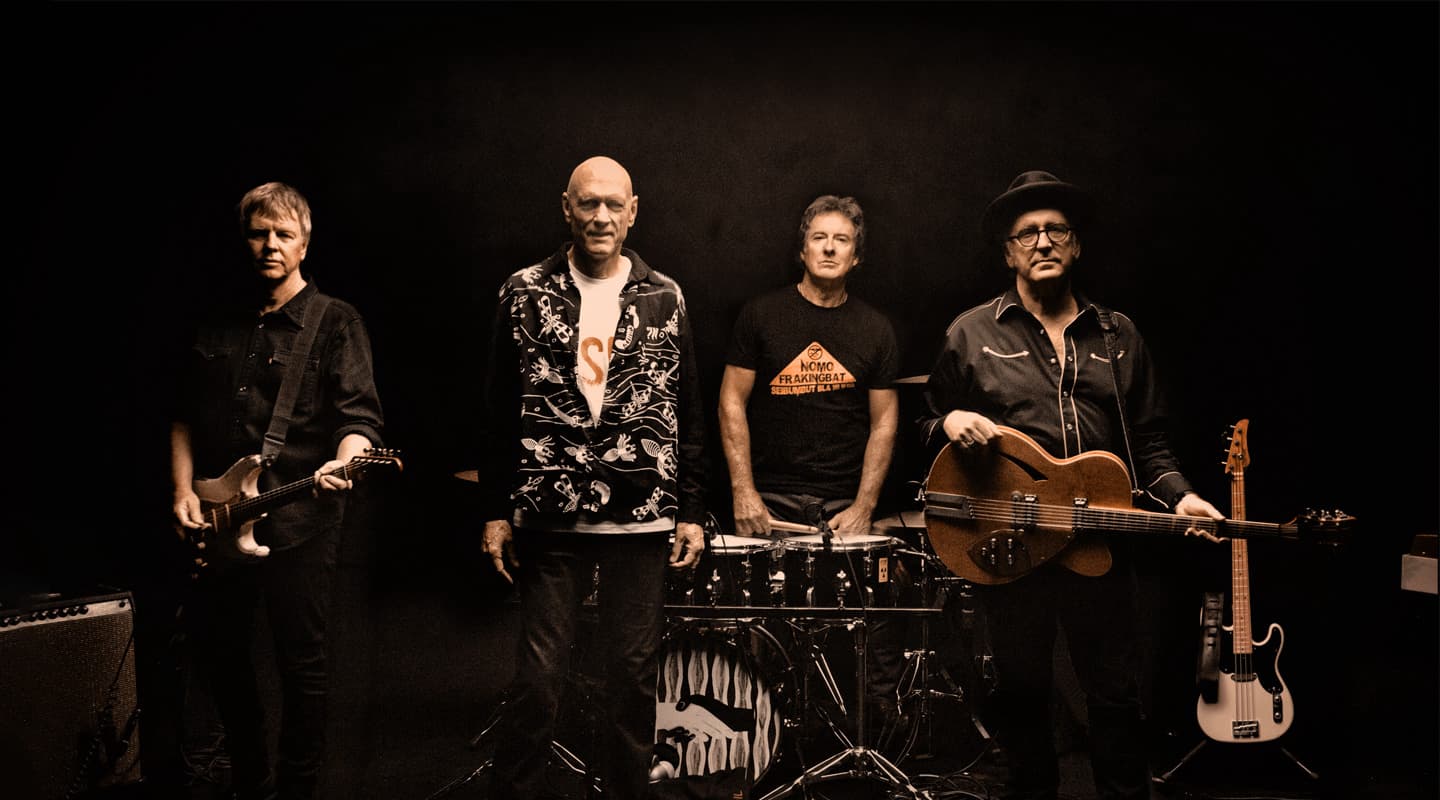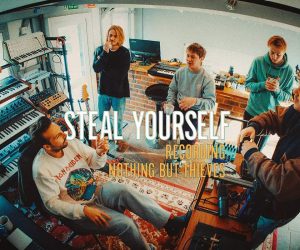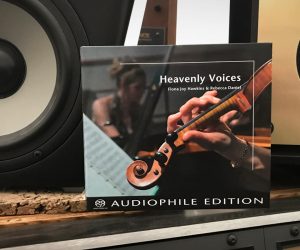
Recording Midnight Oil’s Resist
What started as an extended jam in their ‘clubhouse’ turned into the first Midnight Oils studio album in 20 years. AT talks to The Oils’ Jim Moginie and producer Warne Livesey about how they recorded ‘Resist’.
Photos: Robert Hambling
Breaking out of the northern beaches of Sydney in the late 1970s, Midnight Oil went on to become one of Australia’s most revered and electrifying bands. Many of their songs have been etched into the Australian psyche. And from day one, they’ve never strayed from their unwavering ideology in bringing awareness to the masses on social, environmental, indigenous and political issues. The band’s new album ‘Resist’, is the group’s 13th studio album and continues in the tradition of affirming and showcasing all the elements that have made Midnight Oil who they are. Along with the new album, the group has also announced that they will embark on one final tour before retiring from the live circuit.
CLUBHOUSE JAM
The initial ideas which later morphed into the songs that would form the core of ‘Resist’ were sparked when the band members regrouped at their ‘clubhouse’ prior to venturing out on their European tour in 2019. “Before we went out on that 2019 tour, we went into my little studio in Brookvale called Oceanic Studio,” explains the Oils’ mainstay guitarist-keyboardist Jim Moginie. “It is basically the band’s club house where we can hang out and talk, have a cup of tea, make noise and play music. We had a basic demo set up there with just three mics on the drum kit, Glyn Johns-style — we weren’t trying to get any finished sounds at that point. We spent about six weeks up there before the tour and during that time, we were writing a lot.
“Rob [Hirst] brought in a couple of strong songs first, and then Peter [Garrett] had some songs, and so I rifled through my books and found a few things that I fleshed out like ‘Rising Seas’. Then Rob had a few more unfinished things too, so we worked on those and we went in and recorded demos at Oceanic for them which I engineered as well, since there was no engineer. Bones [Hillman, who sadly passed away in 2020] was still over in the USA so there was only the four of us there. A lot of activity came out of those sessions, a lot of variety and textures, especially guitar sounds using pedals to create atmospheres. All of the songs on the new records came out of those sessions. We put the ideas down with some sort of tempo mapping and then got the arrangements sorted with editing too, and then we went out on our 2019 European tour”.
RANCOM WARES
After the group had returned from that tour, they booked some studio time at Rancom St Studios — which Moginie describes as “a beautiful studio with a nice MCI JH board and a variety of acoustic spaces” — situated in Botany, south of Sydney, and owned by ex-Sherbet keyboardist Garth Porter. For the recording sessions the band reunited with producer Warne Livesey who had previously worked with the band on their ‘Diesel And Dust’, ‘Blue Sky Mining’, ‘Capricornia’ and ‘Redneck Wonderland’ albums.
“Initially we were thinking of who we would get to produce the record,” explains Moginie. “We thought it was better if we didn’t produce ourselves, as that’s always tricky, so we decided to get someone we already knew. As we hadn’t recorded for about 20 years, we felt if we got someone new, they’d either be intimidated by us or they’d probably take us in a direction which wasn’t us, so we decided to call Warne. Warne came out from Canada and did the sessions. He really liked the songs and the demos we’d done. He ended up using some of the sounds and tempo maps from those demos; the unguarded sounds like ‘wobbly’ guitars; and bits and pieces that weren’t really band performances but more ethereal sounds that would be hard to recreate.

PICKING UP 20 YEARS ON
“I love working with The Oils,” affirms the English-born Livesey, on working with the band again. “It is amazing, even after such a long break, how quickly it felt like there had been no time at all since we last worked together. I guess the fundamental relationships don’t change much so it was very comfortable and creatively exciting. They have always been one of my favourite bands to work with and these recordings were no different. But the one thing I noticed is that every member of the band had become even better as musicians, singers and writers. And that’s bearing in mind they were already amazing before.
“We had about 21 songs and we recorded 19 of them and kind of half recorded the last two,” continues Moginie. “In six weeks of working nine-to-five, Monday to Friday, we barrelled through the songs. Then we went back to Oceanic for the final two weeks to lay down some piano and Hammond C3, add some strings, horns, vocals from Pete, Jess Mauboy, Bunna Lawrie, Adam Goodes, Stan Grant and Tasman Keith and some extra guitar bits that were needed at the last minute. Then we transferred all the drums we had done at Rancom St to my Studer A80 16-track two-inch tape machine and then flew them back into the Pro Tools sessions for some extra juice and thump.”
MICROPHONE OPTIONS
When it came to the recording sessions, Livesey set up multiple microphones around the studio environs to capture the best possible sounds. “When we were recording with Warne, he would position drum mics everywhere and anywhere in the room,” reveals Moginie. “And when it came to the mix he’d say, ‘we need a bit more of this on the kick and a bit more space’ or ‘we need a bit more room on the crash’ to which he’d add some sort of room mic that was compressed to the max but had incredible clarity, so the close sounds themselves were very clean with the drums. Then he would dial in the room mics which then became another thing again. Different microphones can totally alter the acoustic space of anything it occupies. The guitars went through the MCI JH console, or some APIs, which was kind of grainy and very good for guitars, and the bass went through a Neve 1073. The lead vocals we used my Neumann U67 through a Neve 1084 and a Distressor.”
“The vocals were generally recorded with Jim’s Neumann U67,” confirms Livesey. “We had a few on the session but Jim’s was the best one for Pete’s vocals. But there were a couple of songs where we wanted a sharper, more aggressive tone where we used a Shure SM7.


ACOUSTIC GUITARS
“For acoustic guitars I used a combination of a Neumann U67 and a Neumann CMV563. Often we recorded Martin and Jim playing together with those mics on each guitar. And on songs where we only used a single acoustic guitar I used a mid-side pair of Neumann U67s [one set to cardioid pattern facing the instrument and a second mic on figure-8 pattern aligned with the first mic but at 90 degrees to the first mic. That second mic is then routed to two channels panned left and right with one of those channels phase reversed].”
“The bass cab was miked with a Neumann tube U47 and there was also a DI. In mixing I often used that DI’ed into a Sans Amp or sometimes I re-amped the bass for more grit.
”Obviously, the Hammond organ and piano were miked, with close mics and stereo room mics in the case of the piano. And we did amp up the Moog as well as printing a DI. Other synths were DI’ed and there’s a bit of soft synths and samples here and there too. The Mellotron was also DI’ed.”
DRUMS: IT’S COMPLICATED
“Drums is where it got complicated,” continues Livesey. “We went through a bunch of different mic positions and choices throughout the bed tracks. But generally, I’d use a Beyer M201 on the snare top. AKG D12 and a sub kick (NS10) on the resonator head and a Shure Beta 52 inside the kick where possible or on the beater side of the batter head where not. Toms were miked with Neumann U87s. Overheads were Telefunken/Shoeps M221Bs. A Shure SM7 on the hats and KM84 on the ride. I had many room mics set up and used different combinations on different songs. But amongst those were my original STC (BBC) 4038 just a couple of feet in front of the kit, a PZM on the floor behind the kit, two AKG 414s as stereo rooms low down and about three metres in front of the kit, and up high a mono Neumann U67 set to omni. I think I also used a Shure SM57 sometimes as well”.


DON’T FIX IT IN THE MIX
Livesey also adheres to the philosophy of getting as close to the final sound as possible when tracking. “I don’t like the ‘printing flat’ idea because I think you need to be working to something close to the final tones whilst you are tracking overdubs,” he says. “You need to shape the sounds of the overdubs to the track. There would be some EQ on almost everything and compression on things like drum room mics, bass, some guitar parts and vocals. I generally don’t print very extreme compression although some of the more edgy vocals were hit pretty hard. But there is always extra processing that happens in mixing as you fine tune the tones.”
Once the recording and mixing were completed, plans were put into motion for a prospective release date. All were in favour initially of releasing the entire batch of songs recorded, but when the pandemic hit, a rethink was considered. “At first we were going to put the whole lot out in the early days of the pandemic,” recalls Moginie, “but just like everybody else, we decided that if you put an album out, then you should be touring behind it, which we couldn’t do. It was frustrating but in the end we decided to wait a year and get all the pieces in place and to do it the right way. In the meantime, we decided to put the ‘The Makarrata Project’ out first which had ‘First Nation’ and ‘Gadigal Land’ and those sort of songs on it with a First Nation theme. And we left the rest of the other stuff intact for the next album, ‘Resist’.
“It was very much all about the subject matter of the songs which was why ‘The Makarrata Project’ was all about First Nation issues, changing the date, and the ‘come on down sit around the camp fire and talk as one people’ idea, and included collaborations from Dan Sultan, Leah Flanagan, Kaleena Briggs, Ursula Yovich, Alice Skye, Troy Cassar Daley, Frank Yamma as well as the ones previously mentioned. We had a posthumous recording of Gurrumul which we laid over ‘Change The Date’ that fitted like a glove and his magic took that song to another level. Bones went back to the USA after the recording and died of cancer late in 2020 just after ‘Makaratta’ got to No.1. It’s still hard to believe such a beautiful man, singer and bass player with us over 30 years has gone. At least he’s all over ‘Makaratta’ and ‘Resist’ and played magnificently.”



























I went to see the Oils recently at Mona Foma Hobart. 2nd Show. It was fantastic. Having been a long time fan as well as being an Audio Engineer and privileged to sat in on the mixing of Hercules and Progress live recordings. It was so good to see them and playing so well. The F. O. H mix by Collin Ellis was faultless as were the staging and Lighting components of the show. Great article AT. Very informative. I hope you get to see the final tour. You won’t be disappointed.
Thanks David!
I have been a fan since 1983. Absolutely loved this article, very sad about Bones, became excited about several MO projects through Pandemic and could see where everything was going. Thanks for all you do. Looking forward to buying another Midnight Oil album in a long while….and sharing it with my University aged kids, which is how old I was when I discovered you all. Much love and peace to all of you. Thanks for listening.